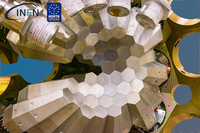Speaker
Description
Abstract
Understanding the structure of near-threshold narrow resonances in C, O and B isotopes is of great importance for nuclear structure studies (e.g., in connection with the onset of collectivization phenomena in cluster nuclei) as well as nuclear astrophysics. In this context, the $\gamma$ decay from near-threshold states, with branches of the order of 10$^{-3}$ – 10$^{-6}$ with respect to particle emission, is one of the most powerful probes of their state wave function. Therefore, highly efficient and high-sensitivity $\gamma$ spectrometers, such as AGATA, are needed. To populate near-threshold resonances in C, O and B isotopes, with cross sections of few mb, fusion reactions induced by intense Li beams on Be, C, Li and B targets can be exploited, followed by the evaporation of a single charged particle, detected in a highly segmented detection system (e.g., a TRACE barrel or GRIT). A remarkable case of study is the decay from a hypothetical narrow resonance in $^{11}$B lying just above the proton-decay threshold, the existence of which has been suggested to explain the observation of unexpectable large proton emission after the β- decay of $^{11}$Be. An explorative experiment performed with GALILEO+TRACE has quoted a $\gamma$-ray branch for this sought resonance, with limited statistical confidence, at 1.12 $\times$ 10$^{-3}$, lying slightly above the theory predictions. AGATA, with a sensitivity gain of more than one order of magnitude, will, therefore, allow more firm conclusions on this peculiar decay branch in $^{11}$B.
This proposal is part of an experimental program on light systems which intends to focus, with similar experimental techniques, on the gamma decay from near-threshold states in additional cases, like neutron-rich $^{17}$O to $^{20}$O.

